In recent Health Tips we have evaluated the “size” of your family and what items are found in a weight-gaining kitchen. In this Health Tip we are going to explore what comprises a healthy kitchen; those items that will not only produce health, but also produce a body that is slim and trim and fit for the Master’s use. We will also consider those items that do not qualify to be in a healthy kitchen.
We are going to begin our search for the answer to a healthy kitchen by going to the source of all truth, the Bible, and see what we can learn from God, the Creator of mankind, about the subject:
“And the Lord God formed man of the dust (dirt, minerals) of the ground, and breathed into his nostrils the breath of life; and man became a living soul. And the Lord God planted a garden eastward of Eden; and there he put the man whom he had formed.” (Genesis 2:7-8) “And out of the ground made the Lord God to grow every tree that is pleasant to the sight, and good for food. . . . And the Lord God took the man, and put him into the garden of Eden to dress it and to keep it. And the Lord God commanded the man, saying, Of every tree of the garden thou mayest freely eat.” (Genesis 2:15-16)Then God gives us an even more detailed description of what food items should be in a healthy kitchen in the following verses:
“AND GOD SAID, Behold, I have given you every herb (vegetable) bearing seed, which is upon the face of all the earth, and every tree in the which is the fruit of a tree yielding seed; to you it shall be for meat (food). . . . AND GOD SAW everything that he had made, and, behold, it was very good.” (Genesis 1:29,31a)What Did God's "Kitchen" Look Like? First, God’s kitchen was located outside in a garden. Because this garden was in a warm climate where food was able to grow year-round, food was readily available on a daily basis. God then created the first "gardeners" - Adam and Eve.
“And the Lord God said it is not good that the man should be alone; I will make him an help meet for him. . . . And the Lord God caused a deep sleep to fall upon ADAM , and he slept: and he took one of his ribs, and closed up the flesh instead thereof; And the rib, which the Lord God had taken from the man, made he a woman. . . . And Adam called his wife’s name EVE.” “Genesis 2:18, 21-22, 3:20) “And Adam said, This is now bone of my bones, and flesh of my flesh: she shall be called Woman, because she was taken out of Man. Therefore shall a man leave his father and his mother and shall cleave unto his wife: and they shall be one flesh.” (Genesis 2:23-24)So what have we learned thus far? God has created a man and then a woman, and placed them in a garden that was to be the source of nourishment for their physical bodies. From these beginning verses in the book of Genesis (the book of Beginnings) we have already learned a lot of information that will help us on our journey to discovering “What a Healthy Kitchen Looks Like.” What Foods Qualify To Be In A Healthy Kitchen? First, let’s take a look at what qualifications God said a food must have in order to qualify as a food to be in the kitchen of Adam and Eve:
“AND GOD SAID, Behold I have given you every herb (vegetable) bearing SEED, which is upon the face of all the earth, and every tree, in the which is the fruit of a tree yielding SEED; to you it shall be for meat (food).” (Genesis 1:29)In other words, the only foods that qualified to meet God’s standard to be in that first kitchen (Adam & Eve’s kitchen) were plant-sourced. Furthermore, these foods had to be living foods that had their enzymes (life force) still intact, and also had the ability to reproduce from a seed. This fact was extremely important, because if the food didn’t have the ability to reproduce for all eternity to support human life, the food supply would run out! This would be the end of man’s ability to live and perpetuate the human race on planet earth. The foods that qualified to be in that first kitchen included all enzymatically alive fruits and vegetables capable of reproducing from the seed contained in the food or on the plant from which the food came, including (but not limited to):
- Fruits: Apples, peaches, pears, plums, nectarines, watermelon, cantaloupe, bananas, persimmon, grapes, blueberries, etc., as well as those foods we often consider vegetables which are technically fruits because they contain the seed within (tomatoes, squash, cucumbers, peppers, avocados, etc).
- Vegetables: Called “herbs” in the Bible, these would include all leafy greens such as lettuce, kale, and collards, as well as celery, cabbage, broccoli, cauliflower, carrots, beets, potatoes, sweet potatoes, kohlrabi, onions, leeks, garlic, as well as the grains of corn, barley, etc, and beans.







